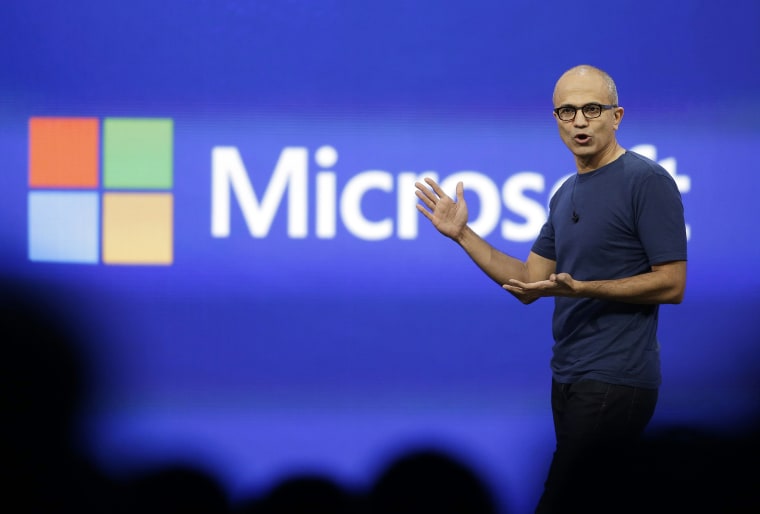Microsoft finally wants to play nice with everyone — on every device.
"We are going to innovate with the challenger mindset ... we are going to come at this by innovating in every dimension," new Microsoft CEO Satya Nadella said at the Microsoft Build developer conference in San Francisco on Wednesday.
Nadella, who became Microsoft CEO in February, used his stage time to stress his plans for Microsoft's future: a company that finally embraces mobile devices and makes it easy for developers to create Microsoft services for multiple platforms.
"We want our users to think about the Windows family and consistency of use," Nadella said Wednesday.
In short: Microsoft now wants to put its services wherever users may be. That may sound like an obvious move for a technology company — or any company, for that matter — but the nascent Nadella era represents a major shift in attitude for Microsoft.
Under former CEO Steve Ballmer, Microsoft failed to anticipate the mobile revolution even as phones and tablets overtook the PC. The company notoriously resisted allowing its crown-jewel products like Office on devices from rivals like Apple.
"We are going to innovate with the challenger mindset ... we are going to come at this by innovating in every dimension," Nadella said.
By contrast, Nadella has pushed a "mobile first, cloud first" Microsoft and has been quick to launch mobile products like Office for iPad.
Wednesday's announcements, which included updates to Windows on phone and desktop, extended Nadella's plans for an expanded Microsoft ecosystem that wants to be involved in every computing situation — and one that's simpler to use for both customers and developers.
"Why should you build for Windows?" Nadella asked, addressing the audience of mostly developers on Wednesday. "I'll give you three reasons."
In addition to the new "challenger mindset," Nadella said, Microsoft plans to "create the broadest platform opportunity" and "bet on this platform ourselves."
Nadella's comments came at the end of the three-hour keynote, and the Microsoft executives who appeared before him introduced several new consumer products and updates.
Windows Phone 8.1 and Cortana voice assistant
First came the unveiling of the new Windows Phone 8.1. While the phone operating system includes several new features, Microsoft spent the lion's share of the Windows Phone 8.1 talk on a particular new feature: Cortana, a Siri-like digital assistant.
"From our point of view, Cortana is the first truly personal assistant," said Joe Belfiore, the head of Windows Phone product management.
Belfiore stressed the "highly personal" aspects of Cortana — named after a character in the video game "Halo." The assistant can manage calendars, keep notes on users' favorite places, avoid calls from specified numbers during "quiet hours" and send a reminder to ask about the new family puppy, for example, the next time a relative calls.
The consumer-friendly Cortana isn't the only big change to Windows Phone. Windows Phone 8.1 will also support signed and encrypted messages, in a move clearly aimed at corporate clients. The update will be available on new phones starting in late April, and to all customers over the next few months.
Windows 8.1 update
Microsoft then moved on to the desktop version of Windows 8, which will also receive a facelift.
Released in 2012, the tile-based and touch-optimized Windows 8 failed to catch on with some fans of the classic Windows look. The new Windows 8.1 update coming Tuesday aims to add back some of those traditional features: Users will be able to boot directly to the classic Windows look, show the traditional taskbar at the bottom of the screen, resize tiles with a click of the mouse, and more.
Future plans for a reintroduced classic Start Menu drew cheers from the audience.
Universal Windows Apps
Microsoft devoted the middle section of the keynote to streamlined services for developers, including "Universal Windows Apps" that will allow them to build apps that work on desktop, mobile — and, eventually, even TV via Microsoft's Xbox gaming console.
Free Windows for phones and small tablets
Starting Wednesday, Microsoft will offer Windows for free on phones and other mobile devices with screens of nine inches or smaller. The company will also eventually offer a free version of Windows for "Internet of things" devices like wearables, connected home appliances and more.
Nokia Lumia 630 and 635
The last person to appear before Nadella on Wednesday was Stephen Elop, the former CEO of Nokia. Microsoft announced in September that it will buy the Finnish company's phone business for $7.2 billion.
Elop unveiled the Lumia 630 and Lumia 635 handsets, which will sell for $159 and $189 respectively and will be the first to ship with Windows Phone 8.1.
